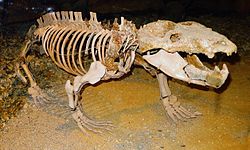| Chiniquodontidae Temporal range: Middle Triassic - Late Triassic | |
|---|---|
 | |
| Restored skeleton of Chiniquodon theotonicus | |
| Scientific classification | |
| Kingdom: | Animalia |
| Phylum: | Chordata |
| Clade: | Synapsida |
| Clade: | Therapsida |
| Clade: | Cynodontia |
| Clade: | Probainognathia |
| Superfamily: | † Chiniquodontoidea von Huene, 1936 |
| Family: | † Chiniquodontidae von Huene, 1936 |
| Genera | |
| |
Chiniquodontidae is an extinct family of basal probainognathian cynodonts that lived in what is now Africa and South America during the Middle and Late Triassic. It is currently thought to include four valid genera: Aleodon , Chiniquodon , Cromptodon and Riojanodon . [1] Two additional genera (Belesodon and Probelesodon) are usually regarded as junior synonyms of Chiniquodon. [2] [3]





